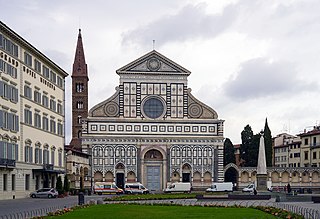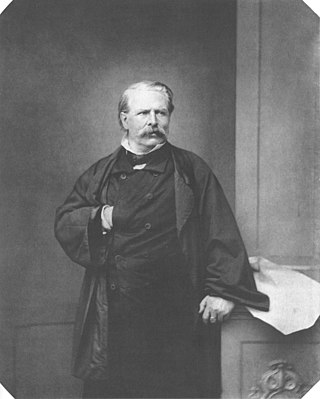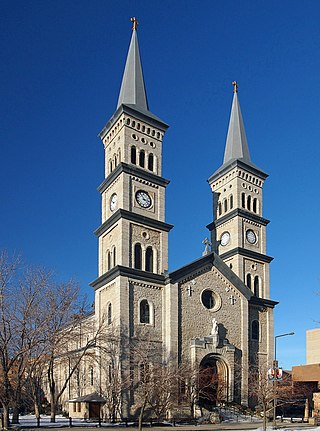
Santa Maria Novella is a church in Florence, Italy, situated opposite, and lending its name to, the city's main railway station. Chronologically, it is the first great basilica in Florence, and is the city's principal Dominican church.

Wilhelm von Kaulbach was a German painter, noted mainly as a muralist, but also as a book illustrator. His murals decorate buildings in Munich. He is associated with the Düsseldorf school of painting.

Peter von Cornelius was a German painter; one of the main representatives of the Nazarene movement. He was the uncle of the composer Peter Cornelius (1824–1874).

Sterzing is a comune in South Tyrol in northern Italy. It is the main town of the southern Wipptal, and the Eisack River flows through the medieval town. It is one of I Borghi più belli d'Italia.

Ludwig Michael Schwanthaler, later ennobled as Ritter von Schwanthaler, was a German sculptor who taught at the Academy of Fine Arts, Munich.

Moritz von Schwind was an Austrian painter, born in Vienna. Schwind's genius was lyrical—he drew inspiration from chivalry, folklore, and the songs of the people. Schwind died in Pöcking in Bavaria, and was buried in the Alter Südfriedhof in Munich.

The Theatine Church of St. Cajetan and Adelaide is a Catholic church in Munich, southern Germany. Built from 1663 to 1690, it was founded by Elector Ferdinand Maria and his wife, Henriette Adelaide of Savoy, as a gesture of thanks for the birth of the long-awaited heir to the Bavarian crown, Prince Max Emanuel, in 1662. Now administered by the Dominican Friars, it is also known as the Dominican Priory of St. Cajetan.

Zwiefalten Abbey is a former Benedictine monastery situated at Zwiefalten near Reutlingen in Baden-Württemberg in Germany. Zwiefalten is on the Upper Swabian Baroque Route.

Wilhering Abbey is a Cistercian monastery in Wilhering in Upper Austria, about 8 km (5 mi) from Linz. It was founded in 1146. The buildings, re-constructed in the 18th century, are known for their spectacular Rococo decoration.

The St. Mark's Church or the Church of St. Mark is a Serbian Orthodox church located in the Tašmajdan park in Belgrade, Serbia, near the Parliament of Serbia. It was built in the Serbo-Byzantine style by the Krstić brothers, completed in 1940, on the site of a previous church dating to 1835. It is one of the largest churches in the country. There is a small Russian church next to St. Mark's.

The Dominican Church, also known as the Church of St. Maria Rotunda, is an early Baroque parish church and minor basilica in the historic center of Vienna, Austria. It is the third church built on the same site in the course of time.

Fürstenfeld Abbey is a former Cistercian monastery in Fürstenfeldbruck, Bavaria, Germany.

This article gives an overview about the architecture of Munich, Germany.

The Ludwigstraße in Munich is one of the city's four royal avenues next to the Brienner Straße, the Maximilianstraße and the Prinzregentenstraße. The avenue is named after King Ludwig I of Bavaria. The city's grandest boulevard still maintains its architectural uniformity envisioned as a grand street "worthy the kingdom" as requested by the king. The Ludwigstraße has served for state parades and funeral processions.

The Church of the Assumption Catholic Church was dedicated in 1874 and is the oldest existing church in Saint Paul. It is located at 51 West Seventh Street, in downtown Saint Paul. The building is listed on the National Register of Historic Places.

Ludwigskirche in Old Saarbrücken, Germany, is a Lutheran Baroque-style church. It is the symbol of the city and is considered to be one of the most important Protestant churches in Germany, along with the Dresden Frauenkirche and the St. Michael's Church, Hamburg.

Michaelsberg Abbey or Michelsberg Abbey, also St. Michael's Abbey, Bamberg is a former Benedictine monastery in Bamberg in Bavaria, Germany. After its dissolution in 1803 the buildings were used for the almshouse Vereinigtes Katharinen- und Elisabethen-Spital, which is still there as a retirement home. The former abbey church remains in use as the Michaelskirche.

Szentgotthárd Abbey is a former Cistercian monastery and church in Szentgotthárd Hungary that is now a Roman Catholic parish church.

Innsbruck Cathedral, also known as the Cathedral of St. James, is an eighteenth-century Baroque cathedral of the Roman Catholic Diocese of Innsbruck in the city of Innsbruck, Austria, dedicated to the apostle Saint James, son of Zebedee. Based on designs by the architect Johann Jakob Herkomer, the cathedral was built between 1717 and 1724 on the site of a twelfth-century Romanesque church. The interior is enclosed by three domed vaults spanning the nave, and a dome with lantern above the chancel. With its lavish Baroque interior, executed in part by the Asam brothers, St. James is considered among the most important Baroque buildings in the Tyrol.
Carl Heinrich Hermann was a German fresco-painter.






















